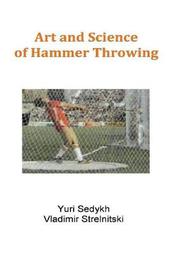
|
Art and Science of Hammer Throwing
Paperback / softback
Main Details
| Title |
Art and Science of Hammer Throwing
|
| Authors and Contributors |
By (author) Yuri Sedykh
|
|
By (author) Vladimir Strelnitski
|
| Physical Properties |
| Format:Paperback / softback | | Pages:116 | | Dimensions(mm): Height 228,Width 152 |
|
| Category/Genre | Track and field sports and athletics |
|---|
| ISBN/Barcode |
9781543943542
|
| Classifications | Dewey:796.4 |
|---|
| Audience | |
|---|
|
Publishing Details |
| Publisher |
BookBaby
|
| Imprint |
BookBaby
|
| Publication Date |
15 September 2018 |
| Publication Country |
United States
|
Description
This book is the first in-depth introduction into the modern technique of hammer throwing, based on the broad application of the laws of physics to rationalize the technique. It is addressed to coaches, throwers, and specialists in biomechanics and physics of sports. It is a result of a collaboration of the two-time Olympic champion, world champion, and the current world record holder Yuri Sedykh and the physicist and coach Dr. Vladimir Strelnitski. The book consists of two major parts (Part 1 and Part 2), the Conclusions, and the Addendum. Part 1 is dedicated to the general characteristics of the hammer/thrower motion. It begins with a brief review of the basic Newtonian mechanics for rectilinear and rotational motion. The acquaintance with such fundamental notions as the reference frame, the linear and angular momentum, the forces and torques as the causes of, respectively, the linear and angular acceleration, are helpful in understanding various elements of technique and the ways of increasing their efficiency. The rest of Part 1 is dedicated to several rarely (or never) discussed aspects of the theory of hammer throwing: the axes of rotation, the origin of the force accelerating the hammer along its orbit, the usefulness of the notion of centrifugal force (often undeservingly denigrated as "fictitious"), and the usefulness of the effect of hammer "hanging" due to gravity. Part 2 is a thorough discussion of the hammer throw technique. The authors emphasize the conventionality of any division of the throw into phases. They put forward their working definition of the beginning of a turn (the beginning of the hammer acceleration after the right foot landing), and they single out the traditional phases of the preliminary winds, the turns, and the delivery. The traditional division of a turn into the double-support and single-support phases partially overlaps with the authors' division of a turn into the "power" phase and "inertial" phase. Each of the throw phases is discussed in detail. The authors introduce two new concepts that help the discussion: the "neutral position" of the thrower (the key position separating the "power" phase of a turn from its "inertial" phase), and the "Point X" (the point where the "lash" of the hammer as a "whip" is attached to the whip's "handle"-the torso and the arms). Part 2 ends with a section discussing the most typical technical errors and the ways of their correction and a section describing a few useful drills helping to master the most challenging elements of technique. The "Conclusions" summarize the major ideas and findings discussed in the book. The Addendum, besides some visual material, contains several sections dedicated to those aspects of the theory of hammer throwing that require more mathematical rigor and the use of calculus. These sections will probably be most interesting to specialists in sports biomechanics and kinesiology.
Author Biography
Yuri Sedykh was born in 1955. He threw the hammer from his age of 12. Two times Olympic champion (1976 and 1980), the world champion (1991) and the current world record holder (86.74 m, 1986). He is currently teaching hammer throwing all over the world. Vladimir Strelnitski, PhD, was born in 1941. He is a retired professor of physics and astrophysics, a hammer coach at Springfield College, MA, and an internationally competing athlete, in his master's age group.
|